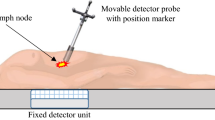Abstract
Objective
Intra-operative probes have recently become important instruments in nuclear medicine. In such an application, the radiopharmaceutical F-18-fluorodeoxy glucose (FDG) is promising. For the FDG-guided surgery, we developed and tested a positron-imaging detector with background rejection capability.
Methods
The detector consists of an array of phoswich scintillators, a multichannel position-sensitive photo-multiplier tube (PSPMT) and an electronic circuit. The scintillators and the PSPMT are encased in a tungsten shield and replaceable collimators are mounted on the top of the detector. Positrons are detected by the plastic scintillators while annihilation photons are detected by the BGOs. By employing a pulse-shape analysis, we can distinguish the true events (positrons) from background gamma events. The dimensions of each plastic scintillator are 2 mm x 2 mm x 3 mm and those of the BGO are 2 mm x 2 mm x 15 mm. These scintillators are optically coupled to each other and combined in an 8 x 8 array, which is optically coupled to a 1-inch square 8x8 multi-channel PSPMT via optical fibers. Position determination of the positrons is performed by 64-channel threshold circuits while the pulse shape analysis is applied for the summing signal.
Results
The spatial resolution was measured by positioning an F-18 point source onto one pixel of the detector and found than the spillover to the neighbor pixel was less than 20%. The background count rate was less than 2 cps for a 20-cm diameter, 20-cm long cylinder phantom containing 3.7 MBq of F-18.
Conclusion
These results indicated that the developed positron-imaging detector will be useful for FDG-guided surgery.
Similar content being viewed by others
References
Hoffman EJ, Tornai MP, Janecek M, Patt BE, Iwanczyk JS. Intraoperative probes and imaging probes.Eur J Nucl Med 1999; 26(8): 913–935.
Britten AJ. A method to evaluate intra-operative gamma probes for sentinel lymph node localization.Eur J Nucl Med 1999; 26 (2): 76–83.
Essner R, Hsueh EC, Haigh PI, Glass EC, Huynh Y, Daghighian F. Application of an F-l 8-fluorodeoxyglucose-sensitive probe for the intraoperative detection of malignancy.J Surg Res 2001; 96: 120–126.
Zervos EE, Desai DC, Depalatis LR, Soble D, Martin EW. F-18-labeled fluorodeoxyglucose positron emission tomography-guided surgery for recurrent colorectal cancer: a feasibility study.J Surg Res 2001; 97: 9–13.
Desai DC, Arnold M, Saha S, Hinkle G, Soble D, Fry J, et al. Correlative whole-body FDG-PET and intraoperative gamma detection of FDG distribution in colorectal cancer.Clinical Positron Imaging 2000; 3 (5): 189–194.
Lederman RJ, Raylman RR, Fisher SJ, Kison PV, San H, Nabel EG, et al. Detection of atherosclerosis using a novel positron-sensitive probe and 18-fluorodeoxyglucose (FDG).Nucl Med Commun 2001; 22 (7): 747–753.
Raylman RR, Wahl RL. A fiber-optically coupled positron-sensitive surgical probe.J Nucl Med 1994; 35 (5): 909–913.
Raylman RR, Wahl RL. Evaluation of ion-implanted-silicon detectors for use in intraoperative positron-sensitive probes.Med Phys 1996; 23 (11): 1889–1895.
Raylman RR, Fisher SJ, Brown RS, Ethier SP, Wahl RL. Fluorine 18-fluorodeoxyglucose-guided breast cancer surgery with a positron-sensitive probe: validation in preclinical studies.Nucl Med 1995; 36 (10): 1869–1874.
Raylman RR. Performance of a dual, solid-state intraoperative probe system with F-18, Tc-99m, and In-111.J Nucl Med 2001; 42 (2): 352–360.
Daghighian F, Mazziotta JC, Hoffman EJ, Shenderov P, Eshaghian B, Siegel S, et al. Intraoperative beta probe: a device for detecting tissue labeled with positron or electron emitting isotopes during surgery.Med Phys 1994; 21 (1): 153–157.
Yasuda S, Makuuchi H, Fujii H, Nakasaki H, Mukai M, Sadahiro S, et al. Evaluation of a surgical gamma probe for detection of18F-FDG.Tokai J Exp Clin Med 2000; 25 (3): 93–99.
Levin CS, Tornai MP, MacDonald LR, et al. Annihilation gamma ray background characterization and rejection for a small beta camera used for tumor localization during surgery.IEEE Trans Nucl Sci 1997; 44: 1120–1126.
Tornai MP, Levin CS, MacDonald LR, et al. A miniature phoswich detector for gamma-ray localization and beta imaging.IEEE Trans Nucl Sci 1998; 45: 1166–1173.
Yamamoto S, Matsumoto K, Senda M. Optimum threshold setting for a positron-sensitive probe with background rejection capability.Ann Nucl Med 2004; 18 (3): 251–256.
Yamamoto S, Matsumoto K, Senda M. An intra-operative positron probe with background rejection capability for FDG-guided surgery.Ann Nucl Med 2005; 19 (1): 23–28.
Yamamoto S, Tarutani K, Suga M, Minato K, Watabe H, Iida H. Development of a phoswich detector for a continuous blood sampling system.IEEE Trans Nucl Sci 2001; 48: 1408–1411.
Liu E, et al. Design and performance of a portable positron-sensitive surgical probe. Conference Records of IEEE Nuclear Science Symposium and Medical Imaging Conference, 2000.
Author information
Authors and Affiliations
Corresponding author
Rights and permissions
About this article
Cite this article
Yamamoto, S., Higashi, T., Matsumoto, K. et al. Development of a positron-imaging detector with background rejection capability. Ann Nucl Med 20, 655–662 (2006). https://doi.org/10.1007/BF02984676
Received:
Accepted:
Issue Date:
DOI: https://doi.org/10.1007/BF02984676




